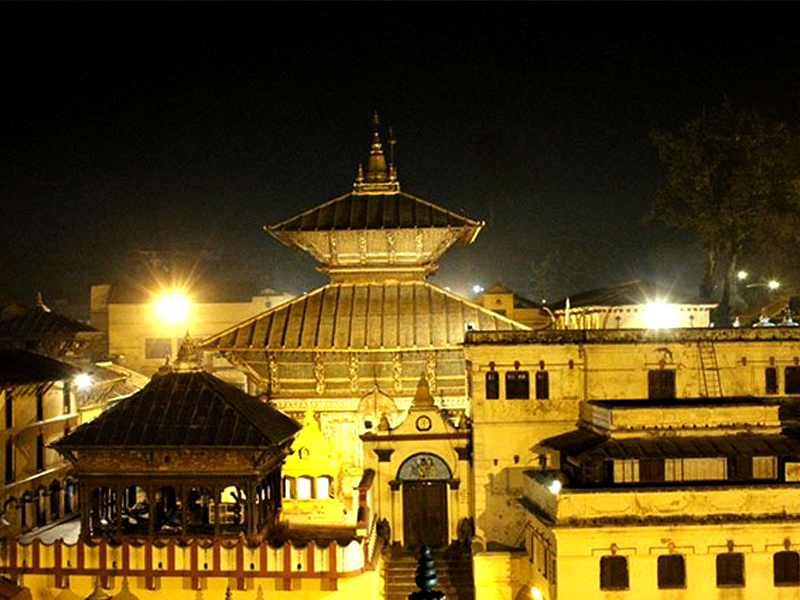How did a Pothead Shiva come to be a Hindu God?
The short answer is through mergers and acquisitions. What!!! Now here comes the elaboration.
Shivaratri is the famous pot smoking festival. Ask anyone and they will either tell you that it’s a religious festival to honor the greatest Hindu God named Shiva or they will tell you that it’s the day when people consume Lord Shiva’s favorite thing, Marijuana.

Sadhus (modern-day version of Shiva’s Shamans) in Pauspatinath Temple
To any person in this day and age, the rationale behind the holy significance of ganja and its close connection with the most revered God is strange, not just to an alien westerner but also to Nepalese who now place global ethics and values above the old local ones.
To understand how a pothead could become the most powerful of all deities, one has to trace roots of Shiva and also learn a little about roots of Hinduism. It is only after decoding Shiva’s origins and his incorporation into Hinduism, we can understand why such a ‘degenerate’ can be a revered God and how a “degenerate’s” substance can be a holy gift. It will also give you a historical background on how pot smoking festival could be so big and followed in this age of science-based progress.

Hindu Temple Pashupatinath, Kathmandu Valley
What is Shamanism?
Shamanism is a term that collectively and loosely defines religions that have concepts of active communication with Gods or spirits through a transcendental state of mind. In the core of all shamanistic beliefs is a notion that when humans are in a trance, they are in active communication with gods or demons or spirits. It is through this ritual they make predictions on when to hunt, farm, cure diseases or everything else for that matter. It begs the question, how do they enter the state of trance? The most common solution was and is naturally occurring hallucinogenic compounds or in common tongue – drugs. The preferred drug of the ancient shamans in this part of the world was Somras, whose recipe is lost to history now. Ayahuasca is one that is still in use by a jungle tribe in the Amazon rainforest of Brazil for that very purpose.
How would that be for a religion? I can imagine it being a very popular religion among some of the youth today, or even in Amsterdam for that matter.

Kirati Sahmans known as "Dhami or Jhakri performing" rituals
How is Shamanism related to the story of Shiva & Shivaratri?
It is because Shiva was originally a Shaman of a Shamanistic religion followed by the Kiratis.
Shiva actually was a deity worshiped by people collectively known as Kiratis. Original Kirati religion is still alive though unfortunately, it is slowly diminishing. Kiratis are indigenous people of Hilly belt between Mid-West Nepal and the eastern boundary of Nepal. Beyond the eastern border of Nepal, Kiratis are also indigenous to regions that are known today as Sikkim, Darjeeling and so on. People identifying themselves as Kiratis are geographically limited to the eastern side of Nepal (from Sankhuwasabha district, all the way to the easternmost part of Nepal and even beyond). Rai, Limbu, Subba, Chamling are few of the common surnames of Kirati people. Large segments of them still identify themselves as Kirati as opposed to Hindu, with regards to their faiths.
The case for Shaman Shiva
In many chapters of Swasthani, a book read at least once every year by most Hindu households in Nepal is read during a month-long period in winter as a tradition. A member of the family reads the book and all the other family members listen. In fact, not so long ago many people learned to read precisely because of this practice (Isn’t that amazing?) making many Nepalese well familiar with Shiva’s personality and life story.
In the chapter where Lord Shiva gets married to a princess with the best possible character (decent, responsible and, of course, a virgin) in a woman and also as a human – Sati Devi. He arrives high on Dhaturo (Dhatura) along with his entourage. The chapters do not shy away from elaborating King Dakhya’s (the bride’s father) sore disappointment and hopelessness for his daughter for she was to wed the degenerate who also happened to be a deity.

Dhaturo – a psychoactive hallucinogenic plant
He shows up at his own wedding high and hallucinating and it’s not just the groom but also the entire groom party. The shabby and savage Shiva as described in the book through King Dakshya’s point of view was an unhygienic and misbehaved wanderer who seemed distant from the ‘civilized etiquettes’. He was revered as a God throughout the realm and beyond. As described in the book, he is hardly conscious when he shows up and King Dakshya had to console his daughter.
Besides the interesting piece of the story mentioned above, there are loads of other suggestive descriptions that make the argument for Shiva being a Shaman very strong. If you need further evidence, learn about the Kirati religion and its practices, both old and new, it becomes apparent that Shiva’s original faith is still Shamanistic.
Many Hindus counter the argument made above in the previous paragraph. They claim that Shiva was a Hindu God from the very beginning, and was never a Shaman God, but only shared a few common characteristics with Shamans. The great anthropologist Nepal has ever seen, Dor Bahadur Bista who is also the famous protégé of the famous anthropologist Christoph Von Furer-Haimendorf, easily counters the Hindu arguments in his famous book, Fatalism, and Development.
In the book, in the chapters discussing Kiratis, he makes several references to the famous holy saga of Mahabharata. In some records of the famous holy war in India, it is mentioned several times that the King of the people of eastern Himalayas (modern-day Nepal – the eastern half) allied with Kauravas and sent a significantly large army. In the book, in which nearly all characters follow some form of Hindu religion, the writers clearly describe the Kiratis as foreigners belonging to the foreign faith. Their main God, who is today known as Lord Shiva (Paruhang in Kirati language) is described as a strange God of strange people, who intoxicate themselves to talk to Gods. There are enough evidence to support that early Hinduism was distinct from shamanistic Kirati religion and they were not part of the same faith until much later.
It was only after expansion of Hinduism that indigenous Kirati religion was brought into the fold of Hinduism like many other indigenous but smaller religions. Note that not all Kiratis adopted Hinduism. In ancient days, most religions were either Shamanistic or Animistic or a combination of both.
It begs the question: when did Hinduism incorporate such many smaller faiths and how come Shiva is the only God today who is still very shamanistic by characteristics. The answer lies in the fact that Kiratis were still a powerful bunch and the Hindus had to accommodate older practices thanks to leverage held by Kiratis. This is a common phenomenon in history – “if you can’t beat them, accommodate them.”
There is another example in the book Fatalism & Development that demonstrates the phenomenon further. When Khas people of Nepal converted to Hinduism in mass, they did not give up the tradition of animal sacrifice.
How exactly was a Shamanistic religion merged with Hindu religion?
Unlike other major religions in the world, Hinduism has a unique history on how it expanded. All three Abrahamic religions expanded through sheer force. Both Christian and Islam have a long history killing off other religions and forcing others to convert to their own faith. Even Buddhism has had a great deal of violence done in its name.
To understand how Hinduism could expand and grow simply by merging with other religions in a, by and large, peaceful manner when many other religions could not, one has to understand the general context of Hinduism and features of smaller religion it merged with. The answer is Animism.
At its core, Hinduism is a nature-worshipping faith like most animistic faiths.
What is Animism?
Animism is the term classified for religions of the most basic and earliest of forms; whose core idea purports that all living things including plants, animals, insects, among others possess a spiritual dimension. Anthropologist Sir Edward Taylor defines animism as “the general doctrine of souls and spiritual beings in general.”
Point to remember: While almost entire of the western world, in general, sees Animism as a primitive and backward form of belief, it is also important to keep in mind a fundamental question: why is belief in a 900 year old ship builder named Noah or ‘a talking snake who told Eve to avoid eating the fruit of knowledge’ more rational and morally superior than beliefs in animal and plant spirits?
How is Animism related to Hinduism?
Animism is well and thriving in this part of the world especially in Hinduism and in many forms of Buddhism such as Mahayana, Bajrayana and especially Nimapa. In most animistic religions, concepts of afterlife and reincarnation are strong and alive.
If one needs a lifetime worth of evidence of animistic roots in Hinduism, one only need to go through the list of many gods each representing many aspects of Nature: Bayu is the God of wind or air, Ganga is the water Goddess, Brahma is the God of stars, Agni is the God of fire, Saraswati is Goddess of knowledge, Indra is the God of rain, Varun is the God of navigation, and so on and so on.
Now that the case for animistic ancestry of Hinduism, it is also imperative to understand why this fact allowed for the peaceful expansion of Hinduism.
Why did Animism allow for smaller religions to merge with Hinduism?
History has enough evidence of religions with similar aspects merging or unifying more easily than ones that do not share many similarities. Examples of both Hinduism and Buddhism having animistic feature are mentioned above. This very fact makes both a very similar religion to followers and hence more acceptable and appealing.
Kathmandu valley itself was almost completely Buddhist just a few centuries ago and now it is majority Hindu among the indigenous population. There are countless temples here that are both Buddhist and Hindu: Mahankal, Batuk Bhairab, the living Goddess Kumari, Taleju and many more. Without much effort, in just over three centuries people subconsciously became Hindu in Kathmandu valley. They still follow a set of Gods that are largely similar while they identify themselves as Hindu.
A phenomenon very similar happened, lead by Shankaracharya, most faiths that saw a little difference with Hindus converted to Hinduism. Why? The basic are nearly the same and easily recognizable.
Why did many Jewish people so easily convert to Christianity and Islam? Why did so many Christians convert to Islam in ancient days? The answer lies in the same roots of all three religions. The biblical character called Abraham is Abraham for both Jews and Christians and its Ibrahim for Muslims. Need more examples? There are plenty, just go search.
When a large number of animists could easily recognize teachings of Garud Puran as easily as recognizing teaching of their own priests, they were more accepting. When combined with political benefits, they did not mind converting without much fuss: like the monotheistic Zoroastrians converted to similar monotheistic religion named Islam or like when Bonpo kings converted to Nimpa Buddhism without much fuss as both were so similar including their scripts, holy attires, and so on.
Expansion of Hinduism
To complete the argument, one has to understand how Hinduism expanded again. It expanded by incorporating indigenous religions to Hinduism. The concept of reincarnation, shared by Hinduism and many animistic religions, allowed all indigenous Gods to reincarnate themselves in different forms of Hindu Gods, leaving no smaller religions out of the fold of Hinduism. Two of the three Abrahamic religions expanded by war and eliminating others but here in the east it was more peaceful and resembled modern-day phenomena like mergers and acquisitions.
Nepal, which has enough of both Hinduism and Buddhism in its history has enough temples and Gods that were originally Kirati or Buddhist but eventually became Hindu: Bhairav is a Buddhist God of animistic roots that converted to Hindu, Guru Rinpoche was a holy figure from modern-day Swat Valley of Pakistan who was responsible for expanding Buddhism in the North of Himalayas is also incorporated in Hinduism as Padmasambhava, Buddha himself became reincarnation of God Vishnu somehow.
This phenomenon can also be verified to a degree from the book – Fatalism & Development.
Conclusion
Old habits die hard, especially in the olden days. In the days when religion was at the core of all aspects of life, no one could forsake the ways of their gods and ancestors completely. The religious mergers and acquisitions could never have happened if it were fully forced by one side rather than through some level of cooperation. The practice of animal sacrifice still lives on in Hinduism in many parts of Nepal despite the fact that Hinduism was largely vegetarian. In some ways that are also how the practice of intoxicating oneself lived on in Hinduism even though the practice now is only limited to honoring Shiva as opposed to communicating with him. That is how a Shaman Paruhang became Hindu Shiva – due to a common phenomenon as shown above.
Original Posted on HONEYGUIDE on 08 March 2016
Related Post
- Visit Nepal 2024
- Political Stability is a must for Nature conservation:
- What is Kathmandu?
- About Prayers Flag
- Nepal World Heritage Site - Lumbini
- 9 Must See Places in Nepal
- Kumari - Mystic Living Goddess of Nepal
- National Heroes of Nepal
- Celebration of Sagarmatha Day
- Did you felt it? — Two Years after the Earthquake
- Buddha was born in Nepal
- Who are Gurkhas? What is Kukri?
- Prince Harry Speech for Gurkhas
- Namaste
- Welcome to Archaic Nepal
Recent Post
- Visit Nepal 2024
- Shrawan Sankranti
- Must Try Off the Beaten Trekking Routes of Nepal
- Political Stability is a must for Nature conservation:
- Combating High Altitude Sickness
- Climate Change and the Himalayas
- What is Kathmandu?
- 13 Necessary Equipment for Peak Climbing in Nepal
- About Prayers Flag
- How did a Pothead Shiva come to be a Hindu God?







